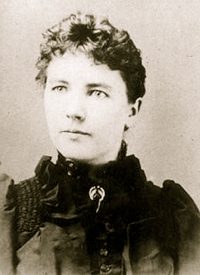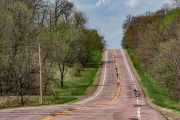
Laura Ingalls Wilder has a birthday coming up. The author of the "Little House" books was born on February 7, 1867 near Pepin, Wisconsin.
The second installment in the nine-book set, Little House on the Prairie (after which the television series was named), has sold tens of millions of copies and has been translated into numerous foreign languages.
The wholesome tales about a frontier family of homesteader have not only been popular with the masses, but are also revered in more select circles. The American Library Association, for instance, presents the Wilder Award to the author or illustrator whose work has made a “substantial and lasting contribution” to children’s literature.
The first book, Little House in the Big Woods, is a quasi-autobiographical account of Ingalls Wilder’s daily life as a child in 19th century Wisconsin. Published in 1932, it is plainly — and warmly — told in the third person. The five Ingallses, snug in a sturdy log home surrounded by a forest full of wild critters, are the personification of faith, family, and freedom.
Although they have scant free time or wealth and must toil endlessly, they don’t come across as pitiful, even when the reader learns that a corncob wrapped in a cloth doubles as Laura’s first doll. Laura’s stories have always been a very welcome addition to the early American historical record, in part
because Ingalls Wilder succeeded in giving the proud pioneers of yesteryear a voice — and a sincere, feminine one at that.
Laura, as those of us familiar with the doings in the "Big Woods" know, is cared for by a pair of enterprising parents whom she calls “Ma” and “Pa.” Ma — Caroline Ingalls — could fashion straw hats from scratch, make her own cheese and smoke and butcher meat. Her abilities as a seamstress weren’t limited to decorative quilts, either. She had to create clothes, sans a sewing machine, sturdy enough to protect her loved ones through frigid weather.
Pa — Charles Ingalls — was no leisurely patriarch. His job was to hunt and fish, or his wife and daughters would starve. Pa made his own bullets, greased his traps, traded his furs at the general store, drove the covered wagon (and the horses), and hewed the logs. Mobility was also his fate. Pa would take advantage of the Homestead Act of 1862 to acquire land in De Smet, South Dakota, the setting for the Little Town on the Prairie segment.
Imagine, Laura’s parents’ adventures didn’t include generous farm subsidies, WIC food packages, or any other government safety net. They even had time to supervise and entertain their children — Pa supplying the stories, Ma supplying the paper dolls, and God supplying the great outdoors.
To jaded ears, Ingalls Wilder’s descriptions of her lot might seem as quotidian as the calico frocks she wore. But they harken to a time when Americans seemed grateful and content with less amenities, and "wellbeing" was a silly buzzword yet to be born.
She writes: “When Laura and Mary had said their prayers and were tucked snugly under the trundle bed’s covers, Pa was sitting in the firelight with the fiddle. Ma had blown out the lamp because she did not need its light. On the other side of the hearth she was swaying gently in her rocking chair, and her knitting needles flashed in and out above the sock she was knitting. The long winter evening of firelight and music had come again.”
Laura’s husband, Almanzo Wilder, whom she met in the Dakota Territory, also rated a book. Farmer Boy details his growing up on a working farm in upstate New York. Like their forebears, the Wilders would be industrious, long-suffering, and blessed. The union of Laura and Almanzo produced an intelligent, spirited daughter, Rose Wilder Lane, born in 1886. In a tribute to Rose, the Cato Institute, the Washington D.C. think tank, has lauded her as a “crusading libertarian writer.”
Laura Ingalls Wilder died at age 90, in Mansfield, Missouri, on Feb. 10, 1957. Fittingly, her life, which began in the Heartland, also ended there.
Thankfully, her charming chronicles live on.



